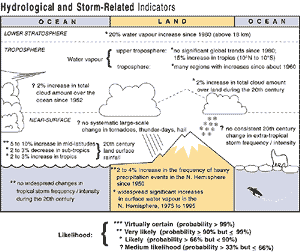2.8 Are the Observed Trends Internally Consistent?

Figure 2.39a: Schematic of observed variations of various temperature
indicators. |

Figure 2.39b: Schematic of observed variations of various hydrological
and storm-related indicators. |
It is very important to compare trends in the various indicators to see if
a physically consistent picture emerges, as this will critically affect the
final assessment of our confidence in any such changes. A number of qualitative
consistencies among the various indicators of climate change have increased
our confidence in our analyses of the historical climate record: Figure
2.39a and b summarises the changes in various
temperature and hydrological indicators, respectively, and provides a measure
of confidence about each change. Of particular relevance are the changes identified
below:
- Temperature over the global land and oceans, with two estimates for the
latter, are measured and adjusted independently, yet all three show quite
consistent increasing trends (0.52 to 0.61°C/century) over the 20th century.
- The nearly worldwide decrease in mountain glacier extent and mass is consistent
with 20th century global temperature increases. A few recent exceptions in
maritime areas have been affected by atmospheric circulation variations and
related precipitation increases.
- Though less certain, substantial proxy evidence points to the exceptional
warmth of the late 20th century relative to the last 1,000 years. The 1990s
are likely to have been the warmest decade of the past 1,000 years over the
Northern Hemisphere as a whole.
- Satellite and balloon measurements agree that lower-tropo-spheric temperatures
have increased only slightly since 1979, though there has been a faster rate
of global surface temp-erature increase. Balloon measurements indicate a larger
lower-tropospheric temperature increase since 1958, similar to that shown
by global surface temperature measurements over the same period. Balloon and
satellite measurements agree that lower-stratospheric temperatures have declined
significantly since 1979.
- Since 1979, trends in worldwide land-surface air temperature derived from
weather stations in the Northern Hemisphere, in regions where urbanisation
is likely to have been strong, agree closely with satellite derived temperature
trends in the lower troposphere above the same regions. This suggests that
urban heat island biases have not significantly affected surface temperature
over the period.
- The decrease in the continental diurnal temperature range since around 1950
coincides with increases in cloud amount and, at least since the mid-1970s
in the Northern Hemisphere, increases in water vapour.
- Decreases in spring snow cover extent since the 1960s, and in the duration
of lake and river ice over at least the last century, relate well to increases
in Northern Hemispheric surface air temperatures.
- The systematic decrease in spring and summer Arctic sea-ice extent in recent
decades is broadly consistent with increases of temperature over most of the
adjacent land and ocean. The large reduction in the thickness of summer and
early autumn Arctic sea ice over the last thirty to forty years is consistent
with this decrease in spatial extent, but we are unsure to what extent poor
temporal sampling and multi-decadal variability are affecting the conclusions.
- The increases in lower-tropospheric water vapour and temperature since the
mid-1970s are qualitatively consistent with an enhanced hydrological cycle.
This is in turn consistent with a greater fraction of precipitation being
delivered from extreme and heavy precipitation events, primarily in areas
with increasing precipitation, e.g., mid- and high latitudes of the Northern
Hemisphere.
- Where data are available, changes in precipitation generally correspond
with consistent changes in streamflow and soil moisture.
We conclude that the variations and trends of the examined indicators consistently
and very strongly support an increasing global surface temperature over at least
the last century, although substantial shorter-term global and regional deviations
from this warming trend are very likely to have occurred.
|